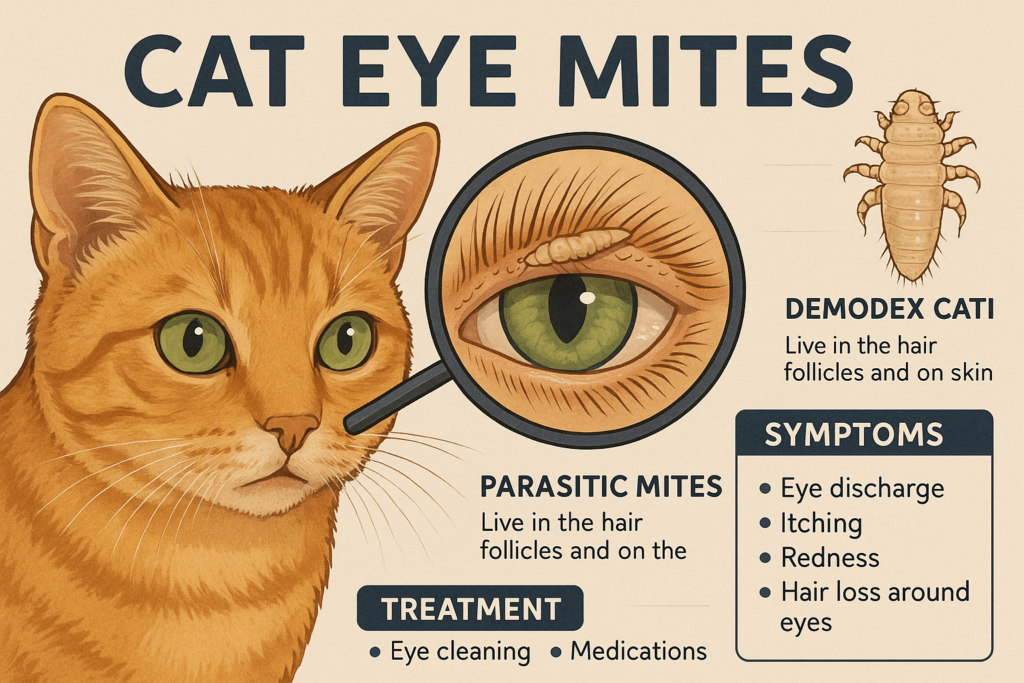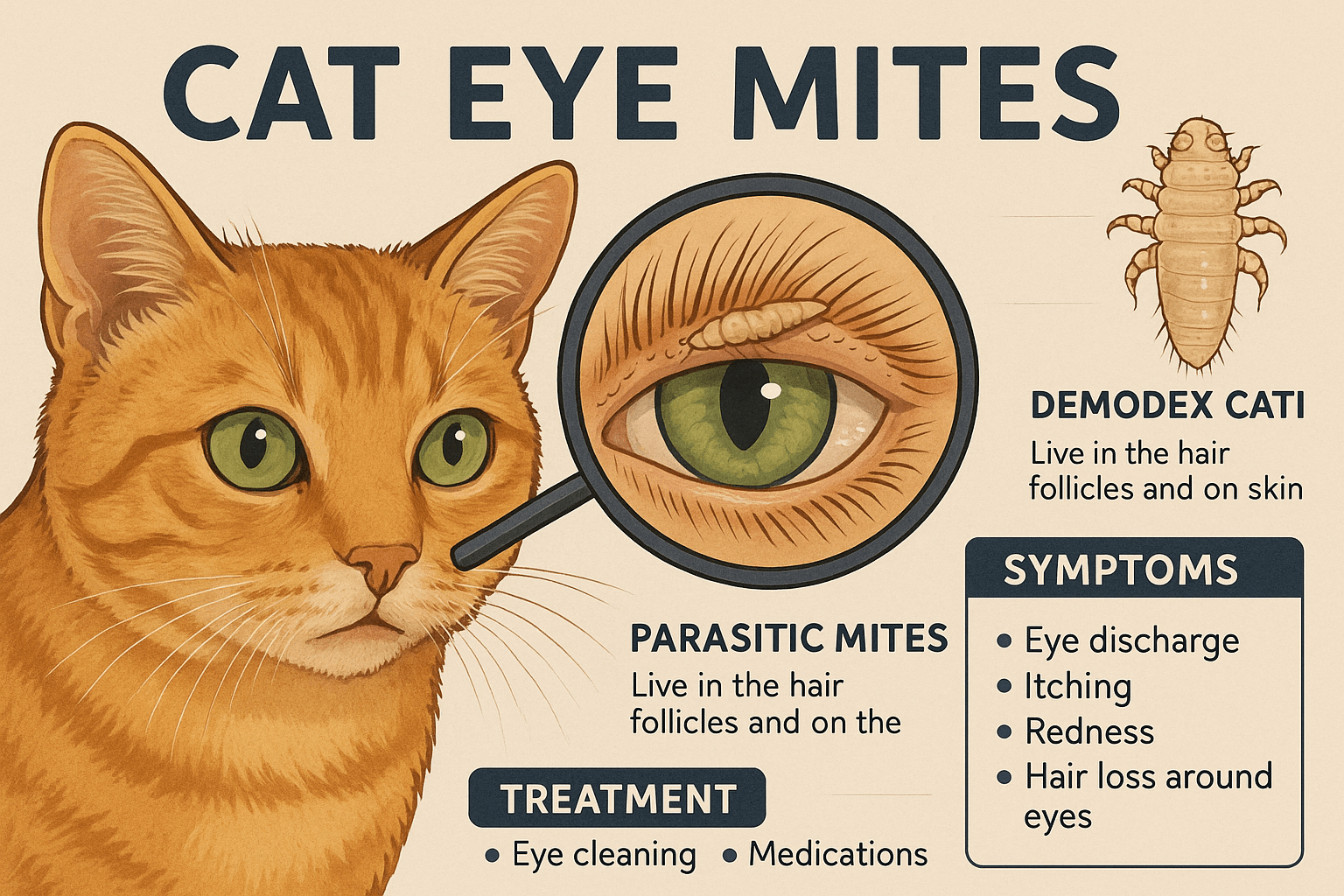Understanding Cat Eye Mites: Causes, Symptoms, and Solutions
Eye mites in cats, though less common than other parasitic infections, can cause significant discomfort and irritation for your feline friend. These tiny parasites, often invisible to the naked eye, thrive in the delicate tissues surrounding a cat’s eyes, leading to symptoms like redness, discharge, and excessive itching. If left untreated, eye mites can lead to more serious complications, including infections or even vision problems. As a responsible cat owner, it’s essential to recognize the signs of eye mites early and take steps to address them promptly. In this guide, we’ll explore everything you need to know about cat eye mites, from identifying symptoms to effective treatment options and preventive measures.
Signs Your Cat May Have Eye Mites
Detecting eye mites in cats requires careful observation of their behavior and physical symptoms. Early identification is key to preventing further complications. Here are some common signs to watch for:
Excessive Blinking or Squinting:
Cats with eye mites often blink frequently or squint due to irritation caused by the parasites.Redness Around the Eyes:
The skin around the eyes may appear inflamed or irritated as a result of constant scratching or rubbing.Watery or Thick Discharge:
A clear or yellowish discharge from the eyes is a telltale sign of an underlying issue, such as mites.Crust Formation Near the Eyes:
Dried discharge or crusty buildup around the eyes can indicate prolonged irritation or infection.Frequent Pawing at the Face:
Cats may paw at their eyes or face in an attempt to relieve the itching caused by mites.
If you notice any of these symptoms, it’s important to consult your veterinarian promptly to confirm the diagnosis and begin treatment.

How to Treat Cat Eye Mites Effectively
Treating cat eye mites involves a combination of veterinary care and home remedies to alleviate discomfort and eliminate the parasites. Follow these steps to ensure a successful recovery.
Visit Your Veterinarian:
A professional diagnosis is crucial to determine whether the issue is caused by mites, allergies, or another condition.Use Prescribed Medications:
Veterinarians often prescribe medicated eye drops or ointments specifically designed to target eye mites.Clean the Affected Area Gently:
Use a warm, damp cloth to clean away any discharge or crust around the eyes before applying treatments.Isolate Infected Cats Temporarily:
To prevent the spread of mites to other pets, isolate the infected cat until the infestation is under control.Monitor Progress Regularly:
Keep track of your cat’s symptoms and report any changes to your vet to ensure the treatment is working effectively.
With proper care and attention, most cats recover fully from eye mite infestations within a few weeks.
Check this guide 👉How to Check for Ear Mites in Cats: Best 7 Expert Tips!
Check this guide 👉Understanding Cat Chin Mites vs Acne: Best 7 Expert Tips!
Check this guide 👉Cat Ear Mites vs Wax: Best 7 Expert Tips!
Prevention Tips for Cat Eye Mites | Treatment Options for Infected Cats |
|---|---|
Keep your cat’s bedding clean and wash regularly | Medicated eye drops prescribed by a vet |
Avoid contact with stray or infected animals | Warm compresses to soothe irritation |
Maintain regular grooming and hygiene routines | Isolation to prevent spreading mites |
Schedule routine vet check-ups for early detection | Antibiotic ointments for secondary infections |
Use parasite prevention products recommended by vets | Monitoring and follow-up appointments |
Preventing Future Eye Mite Infestations
Prevention is always better than cure when it comes to cat eye mites. By implementing simple yet effective measures, you can reduce the risk of reinfestation and keep your cat healthy.
Maintain a Clean Environment:
Regularly clean your cat’s living space, including bedding, toys, and food bowls, to minimize exposure to parasites.Practice Good Hygiene:
Wash your hands after handling your cat, especially if they’ve been outdoors, to avoid transferring mites.Limit Exposure to Strays:
Discourage interactions between your cat and stray animals, which may carry mites or other parasites.Use Preventive Treatments:
Consult your vet about parasite prevention products that can help protect against mites and other pests.Schedule Regular Vet Visits:
Routine check-ups allow your vet to detect potential issues early and provide guidance on maintaining your cat’s health.
By staying proactive, you can significantly lower the chances of your cat contracting eye mites again.
Common Misconceptions About Cat Eye Mites
There are several myths and misconceptions surrounding cat eye mites that can lead to confusion or improper treatment. Understanding the truth behind these claims helps ensure better care for your pet.
Myth: Eye Mites Are Always Visible:
Fact: Eye mites are microscopic and cannot be seen without specialized equipment.Myth: Only Outdoor Cats Get Eye Mites:
Fact: Indoor cats can also contract eye mites through contact with infected animals or contaminated objects.Myth: Home Remedies Alone Are Enough:
Fact: While cleaning and soothing the area can help, professional treatment is necessary to eliminate mites completely.Myth: Eye Mites Are Harmless:
Fact: Untreated eye mites can lead to infections, corneal damage, or vision problems if ignored.Myth: All Eye Issues Are Caused by Mites:
Fact: Other conditions, such as allergies or conjunctivitis, can mimic the symptoms of eye mites. Proper diagnosis is essential.
Dispelling these misconceptions ensures you approach eye mite issues with accurate information and appropriate solutions.
Additional Symptoms to Watch For
In addition to the primary signs of eye mites, there are less obvious symptoms that may indicate an underlying issue. Being aware of these subtle cues can help you address the problem sooner.
Increased Sensitivity to Light:
Cats with eye mites may avoid bright lights or sunlight due to heightened sensitivity caused by irritation.Swollen Eyelids:
Persistent swelling around the eyes can signal an advanced stage of infestation or secondary infection.Loss of Fur Around the Eyes:
Excessive scratching or rubbing may lead to hair loss near the affected area.Behavioral Changes:
A normally playful cat may become lethargic or irritable due to discomfort from eye mites.Unusual Head Shaking:
Some cats shake their heads repeatedly in an attempt to dislodge the source of irritation.
Recognizing these additional symptoms ensures you don’t overlook a potential eye mite problem.
Natural Remedies to Support Treatment
While professional treatment remains the gold standard, natural remedies can complement medical care and provide relief for your cat. These options should be used cautiously and only under veterinary guidance.
Chamomile Tea Compresses:
Soak a cloth in cooled chamomile tea and gently apply it to the affected area to reduce inflammation.Coconut Oil Application:
A small amount of organic coconut oil can moisturize irritated skin and act as a mild antiseptic.Aloe Vera Gel (Pet-Safe):
Apply vet-approved aloe vera gel to soothe itching and promote healing.Diluted Apple Cider Vinegar Wipes:
Mix equal parts water and apple cider vinegar, then use a cotton ball to gently clean the area around the eyes.Probiotic Supplements:
Adding probiotics to your cat’s diet supports overall immune health, helping them fight off infections more effectively.
These natural remedies can enhance your cat’s recovery process when combined with vet-recommended treatments.
When to Seek Emergency Veterinary Care
While many cases of eye mites are manageable at home, some situations require immediate veterinary attention. Knowing when to seek emergency care can save your cat from severe complications.
Severe Swelling or Pus-Like Discharge:
These symptoms may indicate a bacterial infection requiring urgent treatment.Cloudiness or Changes in the Eye:
Any changes in the appearance of the cornea could signal damage or ulceration.Refusal to Eat or Drink:
If your cat stops eating or drinking due to pain or stress, it’s a sign they need immediate help.Aggressive Behavior Toward Touching Their Face:
Sudden aggression when you try to examine their eyes may mean extreme discomfort or fear.Persistent Symptoms Despite Treatment:
If your cat’s condition doesn’t improve after several weeks of treatment, consult your vet for further evaluation.
Recognizing these red flags ensures your cat receives timely care and avoids long-term damage.
Frequently Asked Questions About Cat Eye Mites
Can humans get eye mites from cats?
While rare, certain types of mites can potentially affect humans, but they typically do not survive long outside their host species.
How long does it take to treat eye mites?
Most treatments last 2-4 weeks, depending on the severity of the infestation and the prescribed medication.
Are over-the-counter treatments safe?
It’s best to consult a vet before using any OTC products, as improper use can worsen the condition.
Can I prevent eye mites entirely?
While complete prevention isn’t guaranteed, good hygiene and parasite prevention measures significantly reduce the risk.
What should I do if my cat’s symptoms worsen?
Contact your vet immediately if your cat shows signs of worsening irritation, swelling, or infection during treatment.
Protecting Your Cat from Eye Mites
Cat eye mites may seem daunting, but with the right knowledge and tools, you can manage and prevent them effectively. Recognizing the symptoms early, seeking professional treatment, and maintaining a clean environment are key steps to ensuring your cat’s comfort and well-being. Remember, your feline companion relies on you to provide the care they need to stay healthy and happy. By staying vigilant and proactive, you can safeguard your cat against eye mites and enjoy many joyful years together.
Understanding Cryptosporidium in Cats: Best 7 Expert Tips! – Spot symptoms, treat safely, and stop parasite spread in your home.
Understanding Cryptosporidium in Dogs: Best 7 Expert Tips! – Learn symptoms, treatment & prevention for this stubborn gut parasite.
Understanding Syringomyelia in Cats: Best 7 Expert Tips! – Recognize signs, manage pain, and support your cat’s neurological health with vet-backed guidance.
Understanding Syringomyelia in Dogs: Best 7 Expert Tips! – Expert insights on symptoms, MRI diagnosis, pain management & quality of life.





